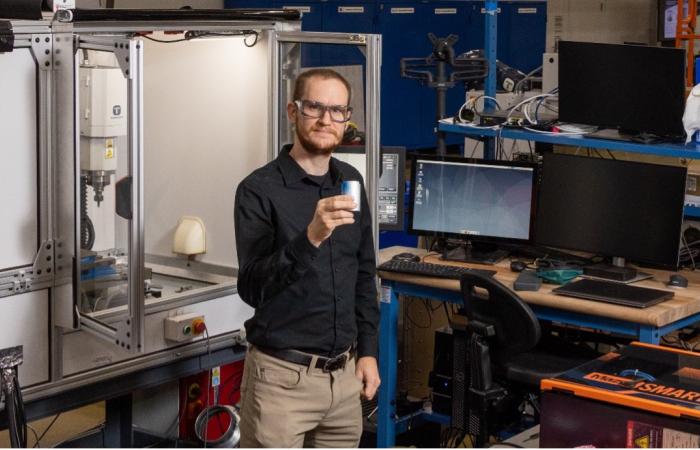
Logan Sturm, Alvin M. Weinberg Fellow at ORNL, creates a mashup between additive manufacturing and cybersecurity research. Credit: Carlos Jones/ORNL, U.S. Dept. of Energy
Logan Sturm, a mechanical engineer at the Department of Energy's Oak Ridge National Laboratory, is sharp. His expertise is in materials and physics. He's strategic - he can see the big picture as soon as he's presented with a challenge. And he has a bit of wit that comes through when coming up with solutions.
At ORNL, Sturm creates a mashup of scientific research, bridging additive manufacturing and cybersecurity science. 3D printing, one of his specialties, is a modern way to produce parts for applications including defense, aerospace and the electrical grid. Yet any part created to maintain the grid or other critical infrastructure is potentially vulnerable to tampering. His latest research is looking into methods to detect counterfeit or incorrectly made items and protect the systems the nation depends on to keep lights on and water flowing.
"Automating manufacturing in the U.S. can be more economical for some industries. For those parts that are made by third-party businesses, we need to verify the product is not counterfeit and opening us up to a problem," said Sturm.
Need to break things to fix them
Without being ironic, Sturm is a curious person who knows the breaking point of an item is the key to making the item work properly. As a kid, he would buy little electronics and gadgets from a flea market and then take them apart to see how they worked. He and his dad also built a computer together. He selected mechanical engineering as a major, he said, because the program exposed him a variety of topics, such as computer programming, electrical circuitry, physics and mechanical knowledge: "I knew I could branch out."
His interest in computers, specifically cybersecurity, stayed with him through graduate school. Today, Sturm is an Alvin M. Weinberg Fellow at ORNL, working on a three-year exploratory research project of his own design. He is closing the gap between manufacturing and cybersecurity sciences, working with both the National Security Sciences Directorate and the Manufacturing Demonstration Facility to connect federal national security organizations with ORNL's facilities.
Staying ahead of adversaries
Sturm's words are calculated and precise. When he describes the research gaps he requested to study during his fellowship, they started with "we need to." We need to better understand the cybersecurity weaknesses in manufacturing systems. We need to improve sensing and data analytics capabilities for advanced manufacturing. We need to better understand human factors and improve cybersecurity awareness and training. We need to do all this in a way that helps small and medium-sized manufacturers.
Researchers can learn through experimentation to help national security decision makers implement security measures before adversaries strike, Sturm explained. Many people have access to 3D printing and can print a variety of products at home for relatively cheap; knowing how to detect counterfeit pieces or tampered items could prevent the grid from going down, could stop a disruption to the supply chain from paused manufacturing processes, or could keep military members safe with properly working equipment.
Merging additive manufacturing with cybersecurity is a rather new amalgamation of industries supporting national security. In addition to his fellowship research, Sturm is thinking about how his scientific results can impact policy across the manufacturing industry. He serves as a working member of a standards committee for ASTM International, an organization that sets standards worldwide for materials, products, systems, and services; Sturm's contribution informs global standards processes of both emerging threats and forthcoming research. The cost-benefit analysis of implementing security measures into manufacturing considers how small and medium businesses can capitalize on the latest technology.







